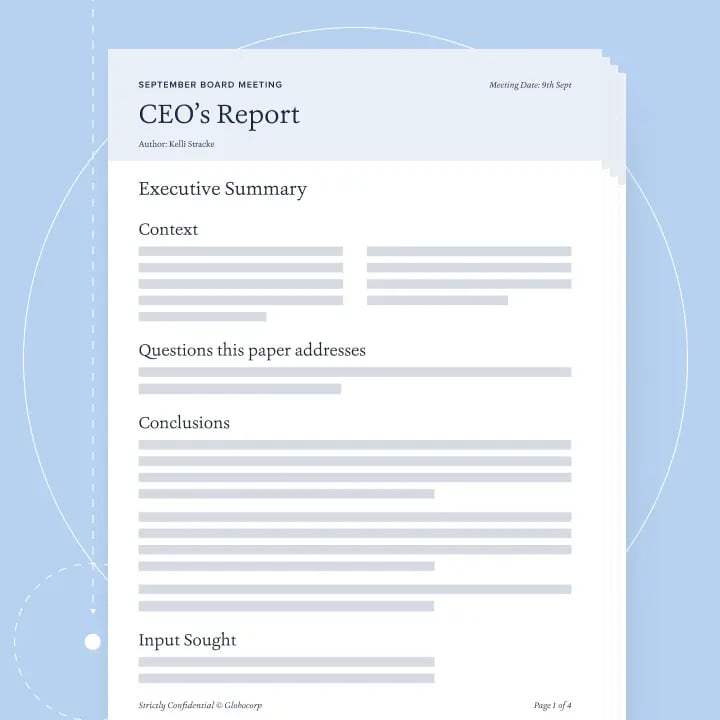Key takeaways
- Most business cases fail because they don’t answer the right questions clearly.
- Our 5-question formula ensures you frame decisions so leaders can say “yes” faster.
- Each question builds clarity around need, request, proposal, options, and action.
- Strong business cases save time, improve credibility, and increase board effectiveness.
- This guide explains how to write cases that get approved, including templates, examples, and advanced strategies for better results.
Why do most business cases fail to get approved?
Most proposals fail because the reasoning is muddy, not because the underlying ideas lack merit. Leaders frequently receive reports that bury the key issue somewhere in the middle or leave them guessing about what decision needs to be made. When the ask isn't clear, even good ideas get stuck in limbo while opportunities slip away.
What is the problem with decision papers and proposals?
Decision papers are often heavy on detail but light on direction. It’s not unheard of for readers to finish a document still unsure why their input is required. The confusion this creates undermines trust and delays progress.
What would green-lighting every decision mean for your career?
Getting first-time approval speeds up delivery and builds your reputation as someone who prepares thoroughly and respects decision-makers' time. When your proposals consistently get the green light without multiple rounds of revisions, colleagues and board members start to trust your judgment and strategic thinking. This credibility opens doors to bigger opportunities and more complex assignments.
The 5-question business case formula that works every time
The most effective cases answer five simple questions with precision. Each one addresses what decision-makers are already asking in their heads. Together, they create a framework you can depend on to get faster, more confident approvals.
Question 1: What is the need and why now?
A case must start with a clear and compelling need grounded in urgency. Decision-makers shouldn’t be left guessing; they should immediately see why action is required as soon as possible. Failure to frame questions this way puts your proposal at risk of being knocked down the priority list.
How do you frame compelling decision requirements?
Define the issue in practical terms that show its importance. Relating it to relevant business risks, opportunities, or compliance pressures builds urgency. The clearer the requirement, the easier it is for others to understand the value.
How can you anchor your case in strategy and goals?
Make sure your proposal connects directly to what your organization prioritizes. Link it to strategy, key performance indicators, or mission to show alignment. Decision-makers approve initiatives that clearly help achieve stated objectives.
Question 2: What is the ask of your reader?
Your reader should never wonder why your paper found its way onto their desk. Be clear about whether you are seeking a decision, approval, or advice. This direct approach prevents wasted time and avoids frustration.
Binary vs advisory decision requests
Some requests are simple yes/no decisions, while others invite feedback. State clearly which type you need so readers know how to respond. This helps meetings run smoothly and makes for efficient decision-making.
How do you make your call-to-action crystal clear?
Place the call-to-action prominently and phrase it in one direct sentence. Make a point not to bury it in background detail or technical jargon. Clear and concise requests have a greater chance of getting the response you want.
Question 3: What do we propose to do and why?
This is the centerpiece of any business case. Outline the proposed action, why it matters, and what resources are needed to make it happen. Credible cases combine a clear outline of the value on offer and a practical plan of action.
How do you outline expected benefits and required resources?
Spell out the benefits in terms of outcomes, savings, or risk reduction. Detail the resources required so the decision feels grounded in reality. Tangible benefits and clear costs help leaders weigh the proposal and reach a decision quickly.
How can you build credibility through objective evaluation?
Use data, benchmarks, or clear evaluation criteria to demonstrate balanced thinking behind your recommendation. Objective comparisons show you've weighed multiple options rather than cherry-picking evidence to support a predetermined conclusion. Readers are more likely to trust a case that doesn’t show bias and anticipates scrutiny.
Question 4: What options did we consider?
Strong cases present more than one solution. Showing alternatives shows that you’ve given the issue some thought and applied critical thinking. It also reassures leaders that your preferred choice is not just an unfounded shot in the dark or assumption.
Why does decision science require multiple options?
Decision quality and outcomes improve when multiple options are considered. Alternatives help boards weigh trade-offs and avoid blind spots. Leave no stone unturned — documenting options strengthens the case, even for seemingly obvious choices.
Why include the "Do Nothing" alternative?
Include the status quo as one of your options to help decision-makers weigh your proposal against doing nothing. This comparison shows the cost of inaction alongside the benefits of moving forward, making the stakes clearer. When readers can see what they risk by maintaining the current approach, your recommendation gains urgency and context.
Question 5: What do we need to do to progress?
Every strong case ends with a clear roadmap for action. Walk decision-makers through the immediate steps required to implement the decision. The simpler the path forward, the easier it is to get agreement.
How do you create specific implementation action plans?
Assign roles and define who will act, when, and with what resources. Concrete action steps show leaders exactly what they're agreeing to when they approve your proposal. Clear implementation details prevent confusion later and demonstrate you've thought through the practical challenges of execution.
How do you communicate the impact of delays or rejection?
Explain the risks of inaction, whether financial, operational, or reputational. This not only gives greater context but stresses the urgency of your request. When leaders see the cost of delay, they are more likely to approve.
Business case templates and examples by use case
Templates help translate the five-question formula into different settings. Each use case requires a slightly different level of detail and framing. These examples show how to adapt your approach.
Board report business cases
Board papers should highlight key decisions upfront and summarize supporting evidence concisely. Use a clear structure as a matter of priority. A well-framed report saves time and drives faster approvals.
Email proposal templates
For quick requests, apply the five questions in just a few email lines. Focus on simplicity and clarity rather than detail. This approach makes it easy for recipients to respond promptly.
New policy implementation cases
Policy cases need to explain the trigger for change, what options were explored, and how the rollout will be managed. Address how the new policy will affect different teams, what the cultural impact would be, and what compliance will look like in practice. A clear timeline with milestones helps boards understand implementation complexity and resource needs.
Investment decision frameworks
Investment cases must quantify costs, benefits, and risks. Using data such as ROI, payback periods, or scenario analysis validates your argument. Boards expect evidence-based reasoning when money and resources are at stake.
Advanced business case writing strategies
Applying the formula is the foundation; refining it creates even stronger outcomes. Advanced strategies give your case additional weight and depth. They also anticipate the questions boards are likely to ask.
How do you use data and analytics to strengthen your case?
Numbers turn assumptions into facts, effectively qualifying choices. Use analytics to measure potential outcomes and back up benefits with hard evidence. Data makes your proposal difficult to dismiss or delay.
Stakeholder analysis and audience targeting
Different audiences value different things and will be impacted differently. Analyze stakeholders in advance and adapt your framing. A board will want strategic impact, while executives may focus on delivery detail.
Risk assessment and mitigation planning
Strong cases address risk openly. List the risks and explain how you will manage them. This transparency bolsters confidence and speeds approval.
Common business case mistakes and how to avoid them
Knowing what to avoid is as valuable as knowing what to do. Many cases fail because they repeat the same errors. Anticipating these pitfalls reinforces your plan of action.
What are the risks of failing to establish urgency and need?
A case without urgency rarely gets prioritized. Always explain why the decision is needed now. Otherwise, your proposal risks being deferred indefinitely.
What are the risks of unclear decision requests and expectations?
If your request is hidden or vague, readers will not know how to respond. Make your request prominently and in plain terms. Precision is the quickest path to approval.
What are the risks of single-option thinking and blinkered analysis?
Rather than instilling confidence, offering only one option suggests narrow thinking. Always document at least two alternatives plus the option of inaction. Doing so shows balance and improves trust in your recommendation.

A thinking and writing platform that helps you to write brilliantly clever and beautiful reports that surface breakthrough insights and spur your business to action.
Find out more


